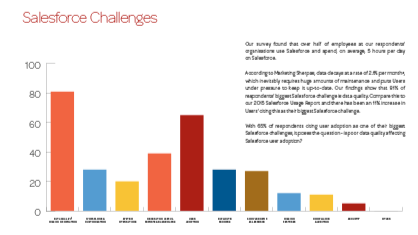Sales Teams’ Biggest Salesforce Challenges and How to Combat Them
Understanding Salesforce Users’ behavior is like a Countdown conundrum – you can never really unscramble all the data quickly enough to get the winning answer. As a CRM software initially designed for Sales teams, the majority of the Salesforce features are focused on arming salespeople with the toolkit they need to hit targets and, ultimately, increase revenue. However, no single sales process is the same, and with unpredictable data, it can be difficult to improve flagging adoption rates.
Biggest Salesforce Challenges
Salesforce isn’t often an out-of-the-box tool. That’s why it supports over 3000 partners by providing them with a marketplace to showcase their products to prospects – the AppExchange. Salesforce understands that Users, especially Sales teams, face challenges with the software that can affect their ability to become the coveted ‘top biller’.
Ebsta’s Salesforce Usage Report 2017 found that the biggest challenge with Users’ sales processes was the time spent on manual and repetitive tasks. Sales teams are challenged by both time and targets so it’s inevitable that they grow increasingly tired by the need to manually update a continuously decaying CRM database. According to MarketingSherpa, data decays at a rate of 2.1% every month meaning sales reps are constantly fighting against out-of-date contact information.
However, all is not lost. The Usage Report found that the majority of respondents are using more than five AppExchange applications, but 68% still believe more could be done to automate their processes.
This poses 3 important questions:
1. Are Salespeople Using the Correct Solutions?
Some organizations decide to play an expensive game of Monopoly when deciding which application to go for. With so many options available, it can be a roll of the dice and fingers-crossed approach when, ultimately, they won’t end up passing ‘Go’ or picking up their $200.
It’s important that organizations listen to the needs of their salespeople, so they invest in the solutions that will help, not hinder them further.
So how do you solve a challenge in Salesforce? Answer these questions to identify if your Salespeople are using the correct solutions:
- Are productivity levels increasing?
- Has User adoption improved?
- Has there been a positive impact on your revenue?
2. Are they implementing the solutions in the correct way?
Utter the words ‘user adoption’ in the Salesforce community and you will be met with a shake of the head and a sigh; it’s one of the most widely-acknowledged challenges with the platform. Why? Because some people like old school – give them an Excel spreadsheet and a call list and they’ll be good to go. But, it’s 2017 and that no longer does the job.
How you implement a new solution can have a direct implication on Salesforce users getting on-board with it. If it’s disjointed and the workflow rules are all over the place, you’re not going to see much ROI. If you’re really serious about hitting super sales, get a Salesforce Administrator onboard to implement, train and scale – after all, companies with a Salesforce Admin are five times more likely to accurately forecast close rates.
3. Are the solutions compatible with each other?
Getting multiple apps to work harmoniously can prove difficult, especially for organizations that don’t have a Salesforce Administrator. It’s not as simple as implementing them and letting them work their magic. Different apps may not work together natively, and it may require some custom implementation within your Salesforce org to get them feeding into each other smoothly.
Take a Salesforce email integration and a Salesforce phone integration as an example. They should work together perfectly, but do you know how?
Make sure you have a Salesforce Administrator that does.
Successful Sales Teams
It’s safe to say that Salesforce adoption rates and bad quality data aren’t the only sales challenges, but they dramatically increase the risk of others – getting in touch with Decision Makers and the length of deal processes. Bad data is a sales rep’s Achilles Heel, but successful implementation of the correct solutions can combat this and ultimately have a tremendous effect on revenue and the ROI of Salesforce.
This is a guest post authored by Katrina Holmes, Content Marketing Manager at Ebsta. Check out Ebsta’s 2017 Salesforce Usage Report here.
